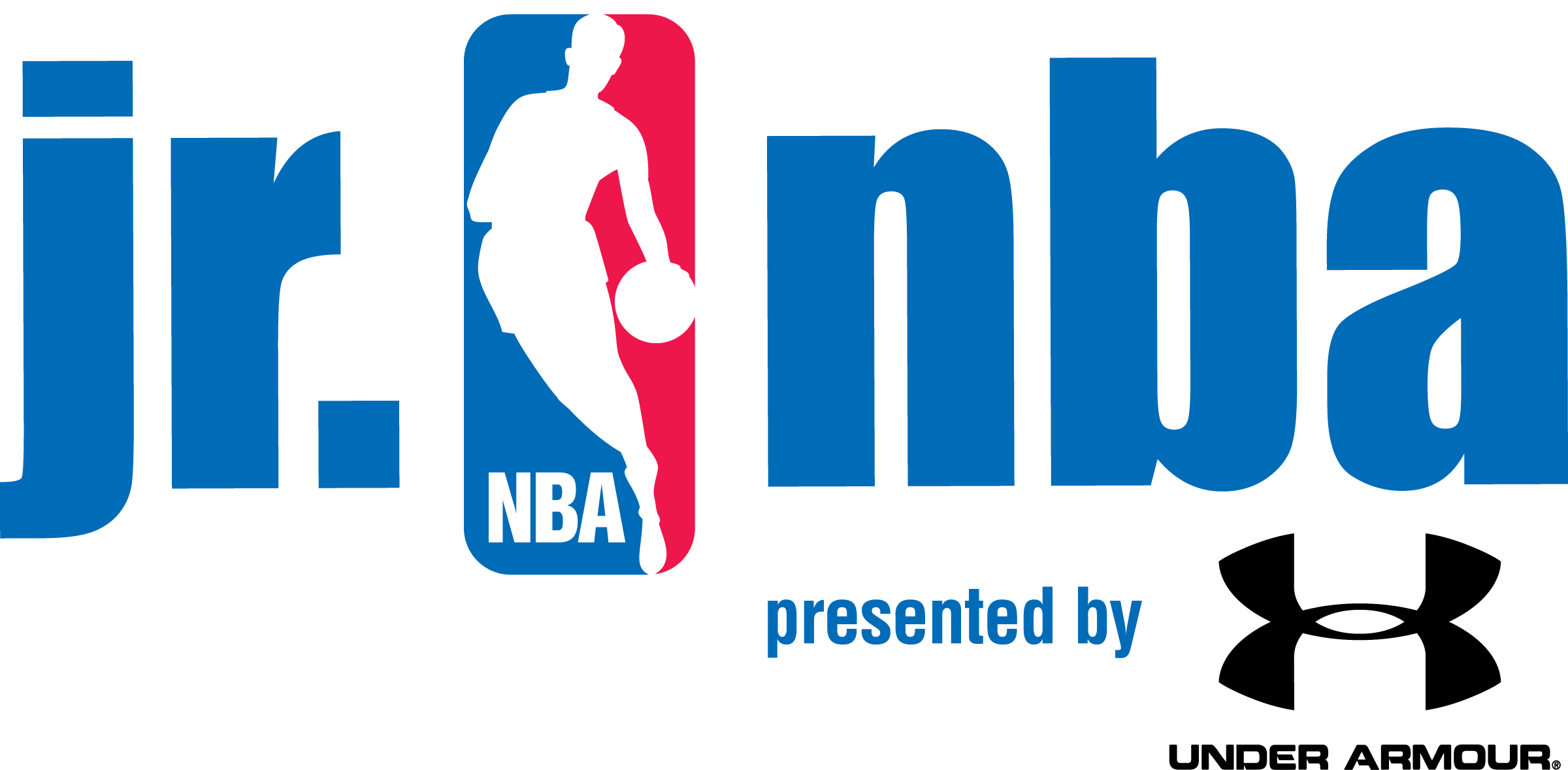
Basketball on the Edge – Top 8 Ways to Impress Your Basketball Coach Vintage Edition
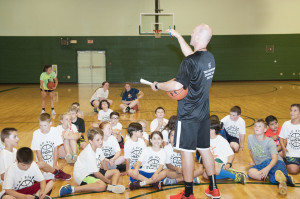
With basketball season upon we thought this would be a great time to revisit this article about how to impress your basketball coach. If you want to make a team, earn a starting spot, or get more playing time this post can help. You can also listen to Coach Mike and Coach Jason go into more detail on the Hoop Heads Podcast Episode that we linked to below.
Episode 4 “Top 8 Ways to Impress Your Basketball Coach”
How can any basketball player catch the attention of their coach at tryouts or during practice? What are the things good coaches are looking for when they watch a particular player? This list is a great place to start when you want to make a team, earn more minutes, and gain your coach’s respect.
1. When your coach is talking, listen and pay attention.
This may seem simple, but for young players with shorter attention spans it can be difficult.
Try to make eye contact with your coach. When they look at you, your eyes should be looking back at them.
Don’t dribble a basketball while your coach is talking!
If your coach is speaking directly to you, nod or respond verbally when your coach is done talking. That way they’ll know that you have understood what they said.
Don’t fool around in line or on the sideline when you are not participating in a drill. This is the quickest way to turn off your coach. If you have a friend on the team that is always playing around, don’t stand by them! Guilt by association is powerful.
Coaches HATE when players don’t listen! Coaches LOVE when players listen.
2. Hustle.
Your coach can teach you how to shoot, pivot, execute a crossover dribble, etc. but they can’t teach you how to hustle! That comes from inside of you.
Hustle during drills, hustle to the coach when they gather the team together, hustle during games and scrimmages, hustling is NEVER wrong!
Hustling is not a skill that can be taught. It is a mindset that you must bring to everything you do on the basketball court.
3. Be the best at something on your team.
A coach will always have room on the team for someone who is the best at a particular skill.
The Best Shooter.
The Best Rebounder.
The Best Passer.
The Best Defender.
The Best Ballhandler.
Become the best on your team at a particular skill and your coach will notice!
4. Communicate.
Good coaches love it when players talk out on the court. Talk on defense, talk on offense.
Communication helps make your teammates better. It makes it easier for the TEAM to function together as a unit.
Great players are talking to their teammates constantly. Call out screens, direct teammates where to be, point out cutters, encourage your teammates with positive talk. “Hey, nice pass!” is an invaluable comment that goes a long way towards building up team spirit.
5. Don’t let mistakes affect your effort.
Everyone makes mistakes. That is how learning occurs. Don’t compound your mistake by pouting or not continuing to give your best effort.
Never let a mistake become two mistakes through lack of effort or concentration.
Learn from your mistakes and try to correct them.
6. Be a Leader.
Demonstrate good sportsmanship at all times.
Be enthusiastic at practice. No coach wants to beg and plead with you every day to get you to play hard.
Be a good teammate that other players want to play with, share the ball, be positive, and play with passion.
7. Show up early.
If you are the first player at practice every day and the last to leave your coach will notice the extra work you are putting in.
Be ready to go the moment the tryout or practice starts.
8. Be Confident.
Skill building is confidence building.
The more you train and develop your basketball skills the more confident you will be.
Great players are confident, not cocky. Great players have the attitude that they can compete with and beat anyone. Great players know they put in the work. All great players have a little swagger that says, “I’ve worked harder than you and I believe that I can beat you!”
Coaches love confident players who will take on the challenge of guarding the other team’s best player or taking the last second shot.
Put in the work and be confident!
Coaches love to find players who fit this description. 6 out of the 8 items on this list have nothing to do with basketball. Developing those skills is a mindset. Combine that mindset with relentless practice and you’ll be on your way to impressing your coach and reaching your basketball goals!
Click here to register for one of our upcoming programs!
Sign up now to get a “Head Start” on your competition with our free basketball tip of the day delivered straight to your inbox. Click below, enter your email and we’ll also send you our E-Book, “Mental Toughness, Improve Your Brain – Improve Your Game”.
Basketball on the Edge – What do Good Coaches Look for at Tryouts – Vintage Edition
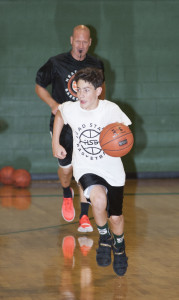
Tryout season for basketball is upon us. Here is a list of tryout items that your coach may be thinking about during tryouts that can help players be more prepared.
Good Coaches will use a combination of drills and games.
As a coach I want to know who can follow directions, learn a new skill, and execute the fundamentals of the game. Coaches can learn these things by putting the players at a tryout through drills.
I also want to know who can play. Some kids look great in drills, but their skills don’t translate to game situations or they have a low basketball IQ. Players should be prepared to play their best in both drills and game settings as they prepare for your tryouts.
Good Coaches will pay attention to the intangibles of each player.
Effort, hustle, and communication will always get noticed! Coaches want players with great intangibles on their team. Bringing these three things to the tryout will increase the odds a player will make the team.
Good Coaches know that culture is the key to success.
A team’s culture starts with the head coach and permeates the entire team down to the last player on the bench. Coaches realize that it’s the end of the bench players that often determine whether the season is fun and successful. I have coached teams in the past where the majority of the coaching staff’s energy was wasted dealing with problems from players that rarely played and were not willing to embrace their role. When players 9-12 on a team buy into the culture the season is waaaay more fun. Demonstrate (through your play & your intangibles – see above) that you are the type of player that will help your coach build a great culture. If you can help your coach build a winning culture he or she will want to keep you around.
Good Coaches know that coachable talent that cares more about the “WE” than the “ME” is what breeds success.
You won’t make the team on intangibles alone, you obviously need to have some talent too. Make sure to put the team first. At tryouts, players should play their game, and not feel the need to shoot every time they touch the ball in order to impress the coach. A good coach can tell pretty quickly who the “basketball players” are compared to those that are just “playing basketball.” Make an impression by encouraging teammates, acknowledging great plays, and being vocal. Combine that with talent and you will be well on your way to making the team.
Good coaches watch offense and defense.
Don’t neglect the defensive end of the floor. Good coaches certainly won’t. Most players at tryouts will be focused on their shooting and scoring. By going against the grain and giving tremendous effort on defense you will stand out from the crowd.
Be ready to play hard, play smart, and COMPETE at tryouts.
Click here to register for one of our upcoming programs!
Sign up now to get a “Head Start” on your competition with our free basketball tip of the day delivered straight to your inbox. Click below, enter your email and we’ll also send you our E-Book, “Mental Toughness, Improve Your Brain – Improve Your Game”.
Basketball on the Edge – The Difference Between a Winner and a Loser – Vintage Edition

What is the difference between a winner and a loser? The characteristics of a winner listed here apply not just to basketball but to life.
Read this list together with your child and discuss what each statement means. Try to think of real life situations inside and outside of basketball where these principals might apply. Make the list a teachable moment. Print out the list and have your young player tape it to the mirror in their bathroom so they see it every day when they wake up. Help them develop the mindset of a winner!
20 Ways to Tell a Winner
1. Winners first want to win!
2. A winner says, “Let’s find out”; a loser says, “Nobody knows.”
3. When a winner makes a mistake he says, “I was wrong”; when a loser makes a mistake he says, “It wasn’t my fault.”
4. A winner goes through a problem; a loser goes around it and never gets past it.
5. A winner makes commitments; a loser makes promises.
6. A winner says,” I’m good, but not as good as I ought to be”; a loser says, “I’m not as bad as a lot of other people.”
7. A winner tries to learn from those who are better than him, a loser tries to tear them down.
8. A winner says, “There ought to be a better way to do it”; a loser says, “That’s the way it’s always been done.”
9. A winner listens and learns; a loser talks about what she’s going to do.
10. A winner asks questions and listens to the answers; a loser never listens.
11. A winner discusses opportunities; a loser complains about problems.
12. A winner welcomes taking a risk to meet a challenge; a loser won’t take a risk.
13. A winner repeats behavior that works and avoids behavior that doesn’t work; a loser repeats behavior because he is comfortable with it.
14. A winner has plans and goals that can be measured; a loser hates measurements.
15. A winner is extremely loyal; a loser doesn’t know the meaning of the word loyalty.
16. A winner keeps statistics; a loser doesn’t want statistics.
17. A winner sets goals daily; a loser doesn’t want to know what goals are.
18. A winner works harder than a loser, and has more time; a loser is always “too busy’ to do what is necessary.
19. A winner isn’t nearly as afraid of losing as a loser is secretly afraid of winning.
20. A winner knows what to fight for and what to compromise on, a loser compromises on what she shouldn’t, and fights for what isn’t worthwhile.
Which one will you choose to be?
Click here to register for one of our upcoming programs!
Sign up now to get a “Head Start” on your competition with our free basketball tip of the day delivered straight to your inbox. Click below, enter your email and we’ll also send you our E-Book, “Mental Toughness, Improve Your Brain – Improve Your Game”.
Basketball on the Edge – Don’t Confuse Basic With Easy
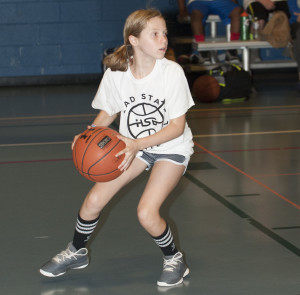
Don’t confuse basic with easy. That’s a concept I learned while interviewing Alan Stein Jr. on the Hoop Heads Podcast two weeks ago. During the podcast Alan explains how he had the opportunity to watch Kobe Bryant train back in 2007.
Here’s the story as he tells it, “I had a chance to watch Kobe do a private workout back in 2007 and aside from being shocked at how early he liked to work out, the part that blew my mind was, here he is the best player in the world and I was thinking he was going to be doing all these fancy drills with flash and sizzle and he was doing such basic stuff. Now it’s Kobe Bryant. So of course everything he’s doing was done with an unparalleled level of effort. His focus was razor sharp, and the drills were done with precision, but the stuff that he was doing was very basic. I remember being so blown away by that until he brought me back down to earth and said, the reason he’s so good is because he doesn’t get bored with the basics. I mean, it was a life changing lesson for me that the basics, yes, they’re often boring. They’re often mundane, but falling in love with the basics and committing to those is always going to be the foundation on which everything else is built and if you want to be able to do a fancier move or a more advanced move, you could only progress to that level once you’ve mastered the levels underneath it. So if you can’t do very basic moves and very basic footwork then please don’t try to emulate your favorite NBA player when they do some type of reverse turnaround fade away. If you’re a kid and you jump to that, that’s basically disrespecting the process and disrespecting the fact that that player has spent years, often decades mastering the basics before they even attempt to do something like that. Here’s where I think a lot of people get confused. They think the word basic and the word easy are synonyms and they’re not. Just because something is basic in theory doesn’t mean that it’s easy to do, in fact, to do basic movements like footwork and pivoting and some of these basic moves, to have the fortitude and the focus to be able to do those relentlessly for hours on end, days, weeks, months, years, and in many cases, decades is not easy to do. If it was easy, everyone else would be doing it. That stuff is incredibly hard so we can’t confuse basic with easy. That was the lesson that I pulled out of watching Kobe’s workout back in 2007”
That is a powerful statement, “Just because something is basic, doesn’t mean it’s easy.” As I talk to coaches, read books, listen to speakers, and try to grow in my profession I’ve come to realize that our goal as coaches should be to keep things as basic and simple as we can for our players. There is no need for overly complicated offenses, drills, or skill development work. Complicated is not better. Players are not getting a score based on “degree of difficulty”. The magic is in the repetition and understanding of simple things like footwork, shooting form, and effort. The best coaches and teachers I’ve been around are able to take complex tasks and make them simple to understand, not the other way around. There is a famous quote from John Wooden, “If they haven’t learned, then you haven’t taught.” The ability to break down a skill into small, easy to understand pieces is the hallmark of a great coach. A fancy drill with lots of bells and whistles that doesn’t translate to an actual game is useless. In fact, it’s worse than useless because the time you’re spending on it could be used practicing basic skills that do translate.
This idea of working on basics over and over again may turn some players and coaches off…but the great ones know that success is found in those basic fundamentals. Would you rather look cool while you’re practicing or play well when the lights come on for a real game? I know which one I’d choose. Success is found every day in the gym working on basic skills like Kobe Bryant did during his career.
Players, can you make 7 out 10 catch and shoot 15 footers at game speed with a defender closing out on you in a practice setting? No? Then you don’t need to work on your between the legs step back three off the dribble. Work relentlessly to master the basic fundamentals (which you never will, you’re human). Can you do that? Day after day? Month after month? Year after year? Not many can. The best players never get bored with the basics. The best coaches teach the basics in such a way so their players can actually learn and apply what they’ve been taught.
It’s not about the latest and greatest. It’s not about the fanciest training with the most props. It’s not about making the game more complex to demonstrate your expertise. It’s about executing the basics of basketball at a high level repeatedly and consistently for long periods of time. Just because it’s basic, doesn’t mean it’s easy!
Click here to register for one of our upcoming programs!
Sign up now to get a “Head Start” on your competition with our free basketball tip of the day delivered straight to your inbox. Click below, enter your email and we’ll also send you our E-Book, “Mental Toughness, Improve Your Brain – Improve Your Game”.
Basketball on the Edge – The Love of a Lifetime
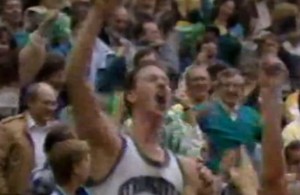
When and why did this love affair begin? I’m not entirely sure. At what point did basketball grab my heart and refuse to let go? I must have had a ball in my crib, but the first photo of me dunking a basketball into a hoop held by my Dad was probably taken when I was about one. Imagine if I had been born in 2018. There would have been hundreds if not thousands of digital pictures of me with my beloved basketball, instead, I grew up in the age of film when every image was precious and you didn’t know what you had until the film got developed (Under 20? Ask your parents what that was like!) Regardless of when the love affair began, it continues as strong as ever to this day.
5 years ago this summer I was invited to play in a charity basketball tournament with two of my college teammates from Kent State, two other former Kent players and, and one friend of my college teammate. I was the oldest player at 43 and the youngest was 39. We won our first game against some guys similar in age to us. We felt pretty good after that first win. Unfortunately, in the second game we ran into some young guys in their early twenties, not very good, but much younger and quicker than any of us. We were losing with about 6 minutes left in the game and as I attempted to stay in front of my opponent on defense I felt a strange feeling in my right knee. Not painful, just strange, like the top half of my leg went one way and the bottom half went the other. I checked out of the game, sat for the remainder of that loss, and then went out into the hallway to test the knee. I wanted to play again because our team only had 6 players and the weekend tournament had just started. After doing some cutting, planting, and jumping out in the hallway between games I decided to give it a go in the next game. I made it about 8 minutes when I felt the same sensation in my knee. I sat out the rest of the day and headed back to the hotel room with my friend Brook Bright who had played at Kent the four years immediately following me. Overnight the knee swelled up so I headed home, dejected that I couldn’t play in the remainder of the tournament and unable to flex my knee more than a few inches. I hobbled around for a few days after that with no improvement at all in the knee’s range of motion. Being stubborn, I hadn’t gone to see the doctor figuring the swelling would eventually subside and I’d recover just like I always had. At this point, my wife insisted I make a doctor’s appointment, so I did. The appointment was set for three days later. By the time the day of the appointment arrived the knee was beginning to loosen up and the swelling was way down. I went to the doctor feeling positive that maybe I had a sprained knee or some other minor issue that time, rest, and ice could cure. Uhhh, No! Immediate diagnosis from the doc within 5 seconds of looking at my knee – torn acl, later verified via an MRI. I was stunned. My injury did not look or feel like the torn acl injuries I’d seen on tv. There was no “pop”. There was no excruciating pain. I simply could not believe that I had a torn acl. I considered surgery and met with the surgeon that would perform the operation, but ultimately, I never had the surgery. Partly because I didn’t want to be laid up for a while and partly because I’m just a little nervous when it comes to surgery. Eventually the knee returned to a normal range of motion and here we are 5 years later. That injury marked the end of my playing career. I wasn’t playing much anyway at the time I was injured. Since my kids had been born there just wasn’t enough time in the day. The injury and my inability to play as well as I would have liked (in other words, my ego) led to my “retirement” from playing ball.
Fast forward to August 3, 2018. Kent State was hosting a Men’s Basketball Alumni Game. I had a decision to make. I was going to head down to Kent for the game to see old friends and teammates regardless, but was I going to play in the game? I hadn’t played any live action basketball since the torn acl. That morning I told myself, “Bring your stuff down so at least you have the option to play if you want.” As I drove the 45 minutes to Kent I was thinking, “a few trips up and down the court, maybe knock in a three, run in straight lines, check yourself out of the game. No doctor’s appointment needed the next day,” Good plan.
As it turned out there were 16 guys that “brought their stuff” to play. 8 players on a team. One guy, Jimmy Hall, graduated in in May of 2018. Several others were still playing professionally in Europe. A few guys younger than me were there, but sitting it out due to previous injuries or other reasons. I was going to be the oldest guy to play in the game. I worried about my knee as the game began, but that worry quickly evaporated as the game was competitive right from the tip. I knew I wasn’t going to be running up and down a few times and then sitting the rest of the game. I played 25 of the 40 minutes. My team lost on a buzzer beater in overtime by the aforementioned Jimmy Hall. I scored 7 points, made a three and two layups, one where I twisted away from a defender and had to land awkwardly. The knee held up! Surprisingly, my body wasn’t stiff or sore the next day like it typically is the day after I participate in some new activity or new exercise (getting old is rough!)
Why did I play in the game? Wasn’t I risking doing more damage to my knee? Wasn’t playing on a torn acl when I hadn’t played in 5 years stupid? YES, but…I had sooo much fun. I remembered why I fell in love with the game back when I was just a little kid on my driveway.
It starts simply with the connections you make with your teammates. Two of the guys on my team I already knew pretty well. One over a pretty long period of time (Brook Bright) and the other I just connected with over the last 6 months (Trevor Huffman). The other guys I knew by name, but had never met before. As soon as the sides were picked the guys came together and instantly we were a team battling side by side, rooting for each other. We were invested. There is nothing like that anywhere else where you can throw 5 guys together and suddenly you’re a “team”. When the game ended, our team was upset that we lost. It was a fun game, a meaningless game, and yet I could feel the sting when it ended in an L.
I realized that I missed the chatter that takes place in the locker room before and after the game. Just sitting around talking and bonding with your teammates. You are a part of something bigger than yourself. That connection with teammates is real. Even in a case like this where the team is only together on the court for an hour or two, basketball brings people together like nothing else I have ever experienced.
Out on the court it was so much fun to match up with an opposing player and test myself against them. I remember a moment from the game where I got boxed out, gave up an offensive rebound basket, and was angry with myself that I wasn’t stronger or in better position to prevent that basket. I remembered that one advantage I always had against guys that were more athletic (could run faster or jump higher) than me was to simply keep moving and out running them. I found that “magic” formula still worked (even at age 48) and led to me getting open for two of my baskets. The opportunities to truly compete have dwindled as I’ve gotten older. I miss the daily battles, putting my abilities to the test against other players out on the court.
I love the feeling I get when a jump shot drops through the basket. There’s nothing better than running back on defense with a little extra spring in your step after your shot swishes through the net. I love finding an open teammate and setting them up to score. When they point at you and say “nice pass”, you know they appreciate you getting them the ball at the right time.
I love the timeouts when guys are high- fiving and fist bumping and sharing words of encouragement. I love the feeling you get on an important possession when the stakes are just a little bit higher. Everyone digs in just a little deeper.
The chance to play one more time at the MAC Center on Kent State’s campus and experience the game as a player again after five years away was too much pass up. Kent State was a place that taught me how to be tough. It taught me how to fight through adversity. My time there wasn’t always fun, in fact many times it was not fun at all. And yet…It is a place that I feel a deep connection and loyalty to even 30 years after I first set foot on the campus as one of 8 freshmen in 1988. Only three of us made it all four years and even for us it was a struggle at times. But in the end, what kept me going back then and what drove me to play in the alumni game last Friday was a love affair with the game that began before I can even remember. I knew I loved the game, but I never realized how much I missed it until last Friday. Thank you basketball for reminding me why I fell in love with you in the first place!
Nothing else can provide moments like this one.
By the way, my eventual college coach at Kent State, Jim McDonald, came to this game, but left in the fourth quarter before the game went into overtime. Somehow, he still decided to offer me his final scholarship despite missing the best moment of my high school career!


